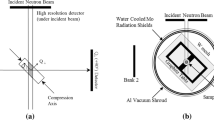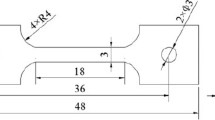Abstract
Flaking has been a major problem in the production of large-size steel forgings. This article discusses the two generally accepted theories of flake formation, with particular reference to stresses caused by alloy segregation. The authors suggest means of producing flake-free steel sections.
Similar content being viewed by others
Bibliography
P. Bardenheuer: Die Flocken in Nickelchromstal, Mitt. K. W. Institute, Eisenforsch, 1925, vol. 7, pp. 1–15.
E. Houdremont and H. Korschan: Die Entstehungsbedingungen der Flocken im Stahl, Stahl und Eisen, 1935, vol. 55, pp. 297–304.
J. H. Andrew, H. Lee, A. K. Mallik, and A. G. Quarrell: The Removal of Hydrogen from Steel, Journal of the Iron and Steel Institute, 1946, vol. 153, no. 1, pp. 67–113.
I. Musatti and A. Reggiori: Quelques remarques sur la formation des flocans dans les acier an chrome-nickel-molybdene, Rev. Mt. (inem.), 1935, vol. 32, pp. 531–552.
J. H. Andrew, A. K. Bose, H. Lee, and A. G. Quarrell: The Formation of Hair-line Cracks, Part II, J. of the Iron and Steel Institute, 1942, vol. 146, no. II, pp. 203–243.
C. A. Zapffe and C. E. Sims: Hydrogen Embrittlement, Internal Stress, and Defects in Steel, AIME TRANS., 1941, vol. 145, pp. 225–261.
A. W. Dana, Jr. F. J. Shortsleeve, and A. R. Troiano: Relation of Flake Formation in Steels to Hydrogen, Microstructure, and Stress, Journal of Metals, August 1955, vol. 7, p. 895.
C. J. Clayton, F. B. Foley, and F. B. Laney: Flaky and Woody Fractures in Nickel Steel Gun Forgings, AIME TRANS., 1920, vol. 62, pp. 211–245.
H. S. Rawdon: Microstructural Features of Flaky Steel, AIME TRANS., 1920, vol. 62, pp. 246–263.
H. Esser, W. Eilender, and A. Bungeroth: Spectroscopic Investigation on Flakes in Chromium-Nickel Steels, Archiv f.d. Eisenhuttenwesen, 1935, vol, 8, pp. 419–423.
F. Sauerwald, H. Gross, and G. G. Neuendorff: Flakes in Nickel Chromium and Related Alloy Steels, Metals and Alloys, 1933, vol. 4, pp. 41–43.
A. L. Baboshin: work described by B. N. Suslov in Metal Progress, 1935, vol. 27, no. 5, pp. 56–58.
E. A. Klausting: Cause of Flake Formation in Steel, Metallurg, 1937, vol. 12, no. 5, pp. 21–23.
J. B. Gero and A. R. Troiano: Segregation: Major Cause of Flakes in Alloy Gun Steels, Iron Age, March 26, 1953, pp. 133–137.
S. S. Nosyreva: Mechanism of Formation of Flakes in Steel, Stahl, 1947, vol. 7, no. 1, pp. 49–52.
C. R. Garr and A. R. Troiano: Flaking of Heavy Alloy Steel Sections, Journal of Metals, April 1957, vol. 9, p. 445.
J. G. Morlet, H. H. Johnson, and A. R. Troiano: A New Concept of Hydrogen Embrittlement in Steel, J. Iron and Steel Institute, May, 1958, vol. 189, pp. 37–44.
H. H. Johnson, J. G. Morlet, and A. R. Troiano: Hydrogen, Crack Initiation, and Delayed Failure in Steel, AIME TRANS., 1958, vol. 212, no. 4, pp. 528–536.
Author information
Authors and Affiliations
Rights and permissions
About this article
Cite this article
Scott, T.E., Troiano, A.R. Hydrogen and segregates in flaking. JOM 11, 619–622 (1959). https://doi.org/10.1007/BF03398192
Published:
Issue Date:
DOI: https://doi.org/10.1007/BF03398192




